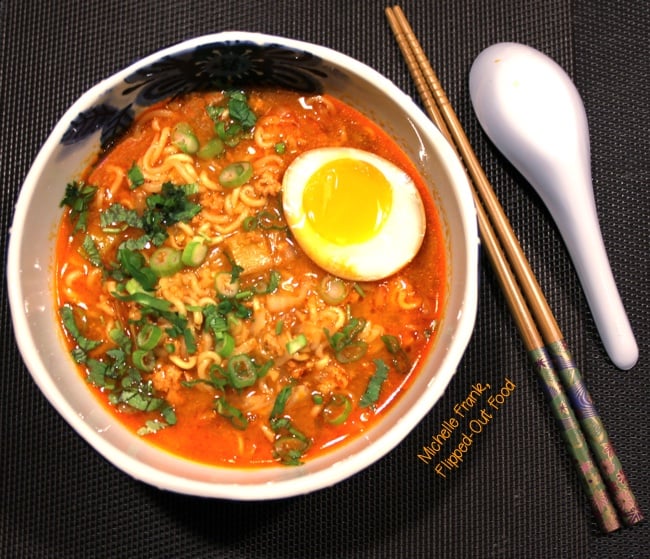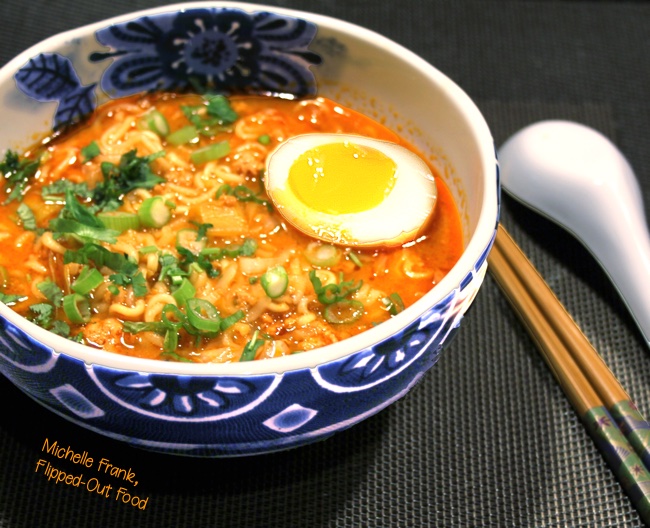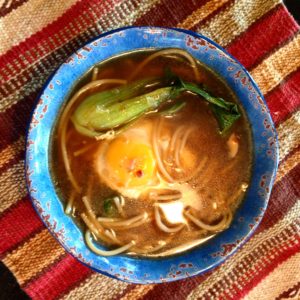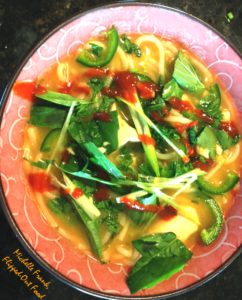Pork-Miso Ramen Soup with Soy-Marinated Egg is the ultimate grown-up ramen noodle soup. The soy-marinated, soft-boiled egg is an umami bomb that perfectly accents the rich, savory broth.

My inspiration for Pork-Miso Ramen Soup with Soy-Marinated Egg
If you've read my "About Me" page, you know that I've eaten ramen soup for many, many years.
The early years involved dumping the noodles and calorie/sodium bomb flavoring packet into a bowl with water and shoving it all in the microwave.
In my quest to create quick dishes using more wholesome ingredients, I came up with my "Grown-Up" Ramen Noodle Soup".
Rather than using the flavor packet that comes with the ramen, I build my own flavor with a combination of broth, soy sauce, sesame oil, ginger, garlic and other flavorful ingredients.
Since that time, I've eaten a lot of ramen in a lot of ramen joints.
I've taken bits and pieces of my favorite things about the soups I've tried and created, Pork-Miso Ramen Soup with Soy-Marinated Egg.
It is the combination of everything I love about the best ramen soup experiences, re-created at home.
My first experience with Miso Ramen with egg
I had my first marinated soft-boiled egg in the ramen soup at Tavernakaya in Madison, WI.
The ramen itself was amazing, but the egg was by far the best part of the meal.
It was perfectly soft-boiled, with a still-custardy yolk. But the flavor that had infused the white was AMAZING. I filed that under "learn how to do this at home".
Then, I had a wonderful miso ramen with spicy ground pork at Ramen Kid (also in Madison; you can see my Yelp review here).
The soft-boiled egg was perfectly cooked, but was not marinated. I filed the spicy pork and miso in the memory banks for later.
Then, I set about making my own version of what was, to me, the perfect ramen soup. And Pork-Miso Ramen Soup with Soy-Marinated Egg was born.
You might notice that the recipe is a fusion of not only Chinese, but also Korean and Japanese ingredients.
So this dish belongs to what I like to call a "food without borders" category.
Work-ahead for Pork-Miso Ramen Soup with Soy-Marinated Egg

The soy-marinated eggs are the most time-consuming part of this recipe, but there's a work-ahead.
I always make the soft-boiled eggs, peel them, and put them in the marinade the night before.
Then, while I'm making the soup (all in one pot—yay!), I take the eggs out of the fridge to let them come up to room temperature.
You can always chop up the veggies you're using in the soup in advance as well: just store them in the fridge in a plastic bag or storage container.
After that, it's a simple matter of sauteing some of the veggies with the pork and gochujang, simmering, then adding the noodles and cabbage and simmering until tender. So simple!
I cut the eggs in half right before serving: the hot broth is enough to heat them through in a matter of minutes.
As you can see in the photo, the soy marinade penetrates into the white of the egg.
Using Leftover meats in ramen soup

Pork-Miso Ramen Soup with Soy-Marinated Egg is perfect for using up any extra meat you might have, like rotisserie chicken or leftover turkey from Thanksgiving or Christmas.
I do this in addition to the ground pork. In the photo here, I added in sliced up leftover pork tenderloin, which was really yummy.
Additional notes
A few final thoughts before I leave you with the recipe for Pork-Miso Ramen Soup with Soy-Marinated Egg:
- Use good-quality ramen noodles for the soup, like those you'd find in the ethnic aisle at your grocery. (I've included an affiliate link below the recipe for the kind I like to use)
- I don't add any salt to the soup at all: the miso paste adds quite a lot of salt, as does the marinated egg. If you need to add more salt after tasting the broth, use a splash or two of tamari.
- If you have leftovers of the soup, the noodles will likely soak up most of the broth. Simply add more broth or water and taste. If you've lost too much flavor, add another teaspoon of miso (see the recipe for tempering instructions).

In between bouts of pho obsession (#phobsession on instagram, HA!), this is now our go-to soup addiction. I hope it's a hit in your house as well!
—xoxo Michelle

Pork-Miso Ramen Soup with Soy-Marinated Egg
The ultimate "grown-up" ramen noodle soup. The soy-marinated, soft-boiled egg is an umami bomb that perfectly accents the rich, savory broth. The marinated eggs can be made a day in advance and kept in the fridge. If you do the marinating step in advance, this soup can be ready in a matter of 25 minutes.
Ingredients
FOR THE SOY-MARINATED EGGS
- 2 large eggs
- ½ cup soy sauce*
- 2 tablespoon fish sauce, (I use Three Crabs)
- 2 tablespoon rice vinegar
- 1 tablespoon sugar or splenda
FOR THE PORK-MISO RAMEN SOUP
- 1 lb ground pork
- ½ small onion,, finely diced
- 1 tablespoon gochujang,, or more to taste (Korean red chili paste)
- ⅛ teaspoon white pepper
- 3 cups chicken or vegetable broth
- 3 cups water
- 2 packages good-quality ramen noodles*
- 2 cups cabbage,, thinly sliced
- 4 scallions,, sliced (keep white part separated from green tops)
- 2 tablespoon miso paste**, (Japanese fermented soy bean paste)
OPTIONAL GARNISHES
- mung bean sprouts,, carefully washed
- cilantro,, chopped
- corn niblets,, warmed
- scallions, (green parts only, thinly sliced)
- tamari, (see note)
- leftover meat, (optional, e.g., rotisserie chicken, sliced pork tenderloin, etc.)
Instructions
FOR THE SOY-MARINATED EGGS (can be made one day in advance)
- Fill a saucepan with sufficient water to cover the eggs by 1 inch. Bring to a gentle boil.
- Using a skimmer or a large spoon, CAREFULLY place the eggs (one by one) into the boiling water on the bottom of the saucepan—do not allow them to thud onto the bottom.
- Gently boil (medium-high heat) for 6 minutes.***
- Meanwhile, make the marinade: combine the soy sauce, fish sauce, rice vinegar, and sugar in a quart-sized zip-top bag.
- After 6 minutes, drain the eggs and add them to an ice water bath. Let sit for 3 minutes.
- Starting with the wide end of the egg, very gently and carefully peel the eggs (the whites will be very delicate). Add the eggs to the marinade and close the zip-top bag, being careful to remove as much air as possible. Place the bag in a steep-sided container (e.g., a pyrex 2-cup measuring cup) and refrigerate until you start making the soup, at least 4 hours and up to 1 day.
FOR THE PORK-MISO RAMEN SOUP
- Sauté the pork for 3 minutes in a 6-quart (or larger) pot or Dutch oven over medium heat. Add the diced onion and sauté for 2 additional minutes. Add the gochujang and pepper; sauté until the gochujang is fragrant, about 1 minute.
- Add the broth and water; bring to a boil, then reduce heat and simmer gently for 10 minutes.
- Add the noodles (I like to crunch them up first—discard any flavoring packets), cabbage, and scallion whites. Continue simmering until the noodles are soft, about 5 minutes. Remove from heat.
- Add in any leftover meat (if using). Place the miso paste in a small bowl. Temper the miso by adding 2–3 ladles of stock and whisking until smooth. Add the tempered miso to the pot and stir to combine. Taste the broth, adjusting as necessary (see note).
- Garnish the soup with scallion greens, cilantro, and any other desired condiments. Place ½ egg per serving on top of the soup. Serve.
Notes
*Tamari or coconut aminos are alternatives to soy sauce. If using coconut aminos, omit the sugar from the marinade.
**If you are salt-sensitive or on a low-sodium diet, decrease the miso paste to 1 tbsp.
I do not salt the soup at all because miso paste can be quite salty. The egg also adds plenty of salty umami flavor. If you need more salt, you can always add a couple of splashes of tamari or soy sauce, but proceed with caution! On the other hand, if the broth tastes too salty for you, stir a cup of hot water into the broth.
***6 minutes of boiling will produce a soft-boiled egg with a custardy, slightly runny yolk as shown in the pictures. If you prefer a more set yolk, increase the cooking time by 30 seconds, or to a maximum of 1 minute (total 7 minutes).
Nutrition Information:
Yield: 4 Serving Size: 1 gramsAmount Per Serving: Unsaturated Fat: 0g
Related Content
 | "Grown up" Ramen Noodle Soup: An easy recipe for Asian Ramen Noodle Soup that's much healthier than the nuke-and-eat version we all grew up with! | |
 | Pressure-Cooker Pho Ga: Pressure-cooker pho ga delivers a rich, flavorful broth in a fraction of the time. Piled high with beautiful garnishes, this healthy soup really satisfies. | |
 | Pressure-Cooker Chicken Stock: a fantastic “set-it-and-forget-it” technique for delivering a rich, flavorful stock in a fraction of the time you’d spend doing it the old-school way. |



Debbie says
You’ve said you have a pho obsession? Well, I have one too: ramen! ? I eat ramen all year round, but sometimes, as the weather turns cold, I have ramen-rama. I’ve had many different ramen recipes and can safely say that this one is awesome. I love the salty/spicy broth and mix of flavors. Each bite is different. And the marinated egg? Genius!!!! I only wish I didn’t half ruin the eggs while peeling them. They still taste great though! This is a new go-to for me. Restaurant quality without the cost (and the added perk of “hey, I did that”). Thanks! I’d give this 10 stars if I could.
Michelle says
Oh, fantastic Debbie!! My "phobsession" switches off with ramen too, actually. And yes, even if it's 100º outside, I'll happily eat either one. 😉 Have you tried peeling the eggs while they're submerged in water? That might help. I'm so glad that this recipe is your go-to!
Agness of Run Agness Run says
This is a truly awesome and mouth-watering ramen soup recipe, Michelle! I can't wait to give it a try, especially because of the combo of ingredients.Is there any alternative to using soy sauce?
Michelle says
Thanks so much, Agness! Worchestershire sauce is often used in place of soy sauce, but I wouldn't recommend it for this application because its strong flavor will become concentrated in the egg—the end result will be quite overpowering. Instead, I'd suggest using either Tamari or coconut aminos. If you opt to use coconut aminos, don't add any sugar (they bring some sweetness to the table on their own). Thanks for bringing this up: I'll add the soy sauce alternatives to my notes!
Corina Blum says
IT sounds like such a delicious soup, especially with those soy marinated eggs - I've never tried anything like that before but would love to give it a go. Thanks so much for sharing with #CookOnceEatTwice
Michelle says
Thank you, Corina! I hope you love it! 🙂
Monika Dabrowski says
I've never tried marinating eggs, sounds like a great way to add lots of flavour to a dish. This is a fabulous recipe for using up leftover meat:)
Michelle says
Thank you, Monika! Figuring out the marinated eggs was an adventure, but after eating them I knew that I just HAD to try it!